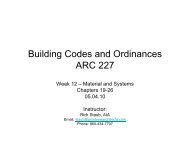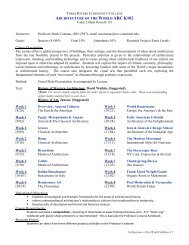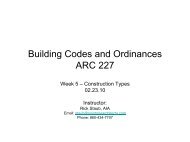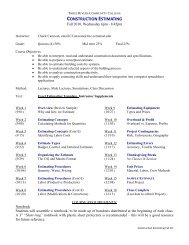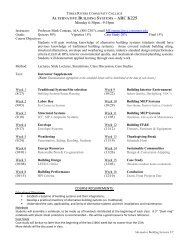architecture of the world arc k102 - Architectural Design Program
architecture of the world arc k102 - Architectural Design Program
architecture of the world arc k102 - Architectural Design Program
Create successful ePaper yourself
Turn your PDF publications into a flip-book with our unique Google optimized e-Paper software.
EXPANDED COURSE OVERVIEWArchitecture <strong>of</strong> <strong>the</strong> World is an informative and intense course. Considerable content will beconveyed to <strong>the</strong> student while building a logical basis for understanding <strong>the</strong> designphilosophies and conditions which shaped <strong><strong>arc</strong>hitecture</strong> from pre-history to <strong>the</strong> present.The course is divided into (four) 4 week sections:The first section examines <strong>the</strong> origins <strong>of</strong> ancient-<strong>world</strong> <strong><strong>arc</strong>hitecture</strong> with specific focus on <strong>the</strong>cultures <strong>of</strong> Egypt, Mesopotamia and <strong>the</strong> Aegean. Differences in climate, geography, materials,philosophy, social structure and technology will be explored to discover how <strong>the</strong>se arereflected in <strong>the</strong> <strong><strong>arc</strong>hitecture</strong> <strong>of</strong> each culture.This section will also explore <strong>the</strong> classical <strong><strong>arc</strong>hitecture</strong> <strong>of</strong> Ancient Greece and Rome, asstudents are introduced to: <strong>the</strong> principles <strong>of</strong> <strong>the</strong> <strong>Architectural</strong> Orders and <strong>the</strong> elements <strong>of</strong>which <strong>the</strong>y are composed; detailing; engineering advances; proportion, and planning <strong>the</strong>ories.Christian Architecture will be traced from its origins in Rome through <strong>the</strong> syn<strong>the</strong>sis <strong>of</strong> form,function, philosophy and structure in <strong>the</strong> Gothic Ca<strong>the</strong>drals.The second section examines <strong>the</strong> origins <strong>of</strong> <strong>the</strong> Renaissance in Italy and <strong>the</strong> development <strong>of</strong><strong>the</strong> various Renaissance styles from Early Renaissance through <strong>the</strong> Baroque Period. Theeconomic, political, social and technical influences which shaped this movement will beexplored to provide a better understanding <strong>of</strong> <strong>the</strong> meaning <strong>of</strong> <strong>the</strong> forms used.This section will also explore <strong>the</strong> spread <strong>of</strong> Renaissance ideas and designs throughout Europe,<strong>the</strong> Americas and <strong>the</strong> East. Particular attention will be placed on <strong>the</strong> development <strong>of</strong>Renaissance design in France and England.The development <strong>of</strong> <strong><strong>arc</strong>hitecture</strong> in America will be traced from <strong>the</strong> Colonial Period through<strong>the</strong> Gothic Revival. Students will explore <strong>the</strong> relationship <strong>of</strong> American <strong><strong>arc</strong>hitecture</strong> to culturaldevelopments in Europe as well as <strong>the</strong> se<strong>arc</strong>h for an appropriate American style.The third section examines how society in general and <strong><strong>arc</strong>hitecture</strong> in particular, reacted to <strong>the</strong>changes and technology brought about by <strong>the</strong> Industrial Revolution. Students will exploreinitial reactions as <strong>the</strong>y found <strong>the</strong>ir expressions in <strong><strong>arc</strong>hitecture</strong>, a period covering <strong>the</strong> yearsroughly between 1850c and 1900c.This section will also examine <strong>the</strong> period covering 1900c to World War I as <strong>arc</strong>hitecturalresponse was refined in a se<strong>arc</strong>h to express <strong>the</strong> new century. The period covering World WarI to World War II is <strong>the</strong> final portion <strong>of</strong> this section to be explored as students discover how<strong>the</strong> war graphically demonstrated <strong>the</strong> immense power <strong>of</strong> technology for both construction anddestruction, thus, causing a general reassessment <strong>of</strong> values in society, <strong><strong>arc</strong>hitecture</strong> and design.The fourth and final section examines <strong>the</strong> period from World War II to <strong>the</strong> present day.Students will discover how America emerged as a World power and leader in technology and<strong>arc</strong>hitectural expression. <strong>Architectural</strong> periods covered which illustrate this include those suchas <strong>the</strong> race <strong>of</strong> <strong>the</strong> skyscraper, <strong>the</strong> Modern Movement, <strong>the</strong> Chicago School, <strong>the</strong> Shingle Style,Post Modernism and more. This section will also explore <strong>the</strong> current period <strong>of</strong> <strong><strong>arc</strong>hitecture</strong> inpractice today as well as provoke discussions concerning <strong>the</strong> civic and social responsibilities <strong>of</strong><strong><strong>arc</strong>hitecture</strong> <strong>of</strong> <strong>the</strong> past and how it may influence that <strong>of</strong> <strong>the</strong> future.Architecture <strong>of</strong> <strong>the</strong> World Syllabus 10’



